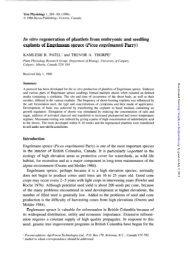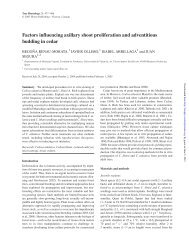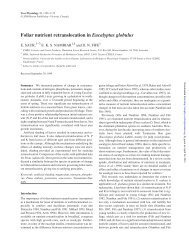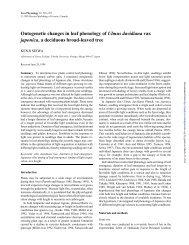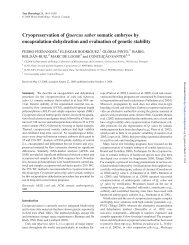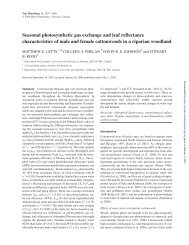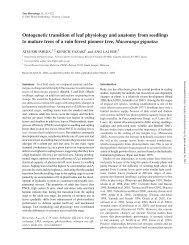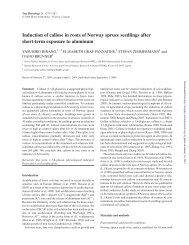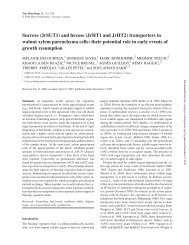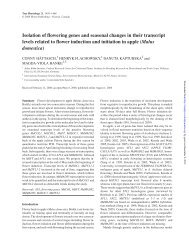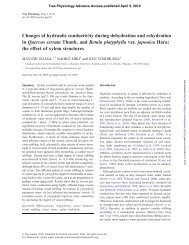Allometry and evaluation of in situ optical LAI ... - Tree Physiology
Allometry and evaluation of in situ optical LAI ... - Tree Physiology
Allometry and evaluation of in situ optical LAI ... - Tree Physiology
Create successful ePaper yourself
Turn your PDF publications into a flip-book with our unique Google optimized e-Paper software.
determ<strong>in</strong>es shoot clump<strong>in</strong>g as the ratio <strong>of</strong> the projected area <strong>of</strong><br />
the needles with<strong>in</strong> the shoot to the vertically projected shoot<br />
area. This technique was further developed by Fassnacht et al.<br />
(1994) <strong>and</strong> corrected by Chen (1996) to <strong>in</strong>clude a greater number<br />
<strong>of</strong> shoot projections for the calculation <strong>of</strong> needle-to-shootarea<br />
ratio, γe. The shoot area is <strong>in</strong>terpreted as the imag<strong>in</strong>ary surface<br />
area <strong>of</strong> a sphere envelop<strong>in</strong>g the leaf-clump <strong>and</strong> is calculated<br />
as a weighted mean ratio <strong>of</strong> the projected shoot silhouette<br />
area (Ap) for different projection angles. Chen (1996) found<br />
good agreement between results <strong>of</strong> shoot analysis for three projection<br />
(camera <strong>in</strong>cidence) angles <strong>and</strong> shoot analysis for 21 <strong>and</strong><br />
39 projection angles, respectively, <strong>and</strong> thus recommended the<br />
use <strong>of</strong> the method by which each shoot from a calibration sample<br />
is imaged <strong>and</strong> analyzed from three camera <strong>in</strong>cidence angles<br />
to estimate the correction parameter (Chen 1996):<br />
with:<br />
<strong>LAI</strong>c = <strong>LAI</strong>eγ<br />
e<br />
(1)<br />
γ e = An/ As<br />
(2)<br />
A<br />
s<br />
(0 ° , 0 ° )cos (15 ° ) (45 ° ,0 ° )cos (45 ° ) (90 ° , 0 ° )cos(75 ° )<br />
A p + A p + A p<br />
= 2<br />
cos(15 ° ) + cos(45 ° ) + cos(75 ° )<br />
where <strong>LAI</strong> c is <strong>LAI</strong> corrected for shoot-level clump<strong>in</strong>g, <strong>LAI</strong> e is<br />
effective <strong>LAI</strong> as estimated by the <strong>optical</strong> devices, γe is the ratio<br />
<strong>of</strong> needle-to-shoot area, An is half the total needle area for all<br />
the needles <strong>of</strong> a shoot, As is half the total shoot imag<strong>in</strong>ary surface<br />
area, <strong>and</strong> Ap (θ, φ) is the projected area for given angles <strong>of</strong><br />
θ <strong>and</strong> φ, where θ <strong>and</strong> φ are the azimuth <strong>and</strong> zenith projection<br />
angles <strong>in</strong> relation to the ma<strong>in</strong> axis <strong>of</strong> the shoot, respectively.<br />
Ten <strong>in</strong>tact shoot samples were taken from each model tree<br />
<strong>and</strong> different model branches to obta<strong>in</strong> the with<strong>in</strong>-shoot clump<strong>in</strong>g<br />
factor. Half the total needle area <strong>in</strong> the shoot (An) was<br />
measured as the projected area <strong>of</strong> needles multiplied by a correction<br />
factor dependent on the hemi-cyl<strong>in</strong>drical shape <strong>of</strong> the<br />
needles. Projected area for the needles <strong>of</strong> the shoots was determ<strong>in</strong>ed<br />
with a Li-Cor planimeter, <strong>and</strong> the correction factor <strong>of</strong><br />
1+π/2 (Bond-Lamberty et al. 2003) was applied. The imag<strong>in</strong>ary<br />
shoot area was obta<strong>in</strong>ed from the projected shoot area<br />
(Ap) at three view<strong>in</strong>g angles (0, 45 <strong>and</strong> 90°) with a Kodak DCS<br />
660 digital camera. The correspond<strong>in</strong>g images were digitally<br />
analyzed accord<strong>in</strong>g to the methodology developed by Chen<br />
(1996) to assess the shoot silhouette area. Mean γe (= 2.001)<br />
was calculated as the arithmetic mean <strong>of</strong> the shoot samples.<br />
St<strong>and</strong>-level clump<strong>in</strong>g To correct for clump<strong>in</strong>g with<strong>in</strong> a st<strong>and</strong><br />
at all scales greater than the shoot, <strong>in</strong>clud<strong>in</strong>g with<strong>in</strong>-crown<br />
clump<strong>in</strong>g, Ωe was obta<strong>in</strong>ed from TRAC (Leblanc 2002) as:<br />
Ω e<br />
⎛ ( Fm − Fmr)<br />
⎞ lnF<br />
= ⎜1<br />
+ ⎟<br />
⎝ 1−<br />
F ⎠ lnF<br />
m<br />
ALLOMETRY AND EVALUATION OF OPTICAL <strong>LAI</strong> DETERMINATION 727<br />
where Fm is the measured total canopy gap fraction <strong>and</strong> Fmr is<br />
the gap fraction <strong>of</strong> an imag<strong>in</strong>ary canopy with the same <strong>LAI</strong> as<br />
the clumped canopy, but where the foliage elements are considered<br />
spatially r<strong>and</strong>om. We measured Fm with TRAC along<br />
transects <strong>in</strong> the st<strong>and</strong> on October 7, 2002, (see Figure 1 for<br />
m<br />
mr<br />
(3)<br />
(4)<br />
sampl<strong>in</strong>g strategy) as the transmittance <strong>of</strong> direct or diffused radiation<br />
at the zenith angle <strong>of</strong> 57.5°. We derived Fmr from the<br />
measured gap size distribution by a gap removal approach. All<br />
transects were analyzed with the TRACW<strong>in</strong> s<strong>of</strong>tware provided<br />
with the <strong>in</strong>strument. The calculated value for Ωe was 0.836.<br />
We calculated <strong>LAI</strong>B as (Chen <strong>and</strong> Cihlar 1995):<br />
<strong>LAI</strong> = <strong>LAI</strong> / Ω<br />
(5)<br />
B e e<br />
where <strong>LAI</strong> B is <strong>LAI</strong> corrected for branch- <strong>and</strong> tree-level clump<strong>in</strong>g<br />
<strong>and</strong> <strong>LAI</strong> e is the effective <strong>LAI</strong> as estimated by the <strong>optical</strong><br />
devices.<br />
Plant area <strong>in</strong>dex To correct for clump<strong>in</strong>g at the with<strong>in</strong>-shoot<br />
<strong>and</strong> above-shoot levels <strong>and</strong> account for the contribution <strong>of</strong><br />
non-photosynthetic components <strong>of</strong> the canopy <strong>in</strong> the <strong>optical</strong><br />
measurements, we calculated the <strong>LAI</strong> associated specifically<br />
with foliage (<strong>LAI</strong>F) as did Chen et al. (1997):<br />
<strong>LAI</strong><br />
F<br />
( 1 − α) <strong>LAI</strong> γ<br />
=<br />
Ω<br />
e<br />
e e<br />
where <strong>LAI</strong> F is <strong>LAI</strong> corrected for with<strong>in</strong>-shoot <strong>and</strong> above-shoot<br />
level clump<strong>in</strong>g <strong>and</strong> α is the woody-to-total area ratio. The<br />
value <strong>of</strong> α was derived from destructive sampl<strong>in</strong>g (Chen et al.<br />
1997): α = W/<strong>LAI</strong>total, where W is the woody area <strong>in</strong>dex <strong>and</strong><br />
<strong>LAI</strong>total is the total <strong>LAI</strong> from woody <strong>and</strong> green foliar material<br />
comb<strong>in</strong>ed.<br />
Our calculation <strong>of</strong> α was based on <strong>in</strong> <strong>situ</strong> measurements <strong>of</strong><br />
foliage <strong>and</strong> woody area per tree, derived from destructive measurements<br />
<strong>of</strong> the branches <strong>and</strong> measured total tree height,<br />
bole length, crown dimensions <strong>and</strong> crown length, <strong>and</strong> plotted<br />
aga<strong>in</strong>st DBH. We applied these relationships to determ<strong>in</strong>e the<br />
mean α <strong>of</strong> the whole st<strong>and</strong> <strong>and</strong> obta<strong>in</strong>ed a value <strong>of</strong> 0.18, which<br />
is consistent with the analysis <strong>of</strong> the digital hemispherical images,<br />
where the amount <strong>of</strong> woody material was estimated by<br />
means <strong>of</strong> image classification, assum<strong>in</strong>g the stems <strong>and</strong><br />
branches seen on the photographs were simple cone shapes<br />
(Barclay et al. 2000).<br />
Results<br />
TREE PHYSIOLOGY ONLINE at http://heronpublish<strong>in</strong>g.com<br />
Allometric relationships<br />
Allometric relationships at the branch <strong>and</strong> tree levels Regression<br />
equations at the branch <strong>and</strong> tree levels were derived from<br />
measurements <strong>of</strong> the six experimental trees (Table 5). The relationships<br />
<strong>in</strong> Table 5 are the best fits <strong>of</strong> the fitted regressions <strong>and</strong><br />
were <strong>in</strong> all cases significant at P < 0.001. They were applied <strong>in</strong><br />
this study to calculate canopy cover <strong>and</strong> PLA at the st<strong>and</strong> level<br />
(Table 5). Allometric relationships between tree height <strong>and</strong><br />
bole length <strong>and</strong> between tree height <strong>and</strong> tree diameter were established<br />
by means <strong>of</strong> the Rayleigh equation (Table 6).<br />
At the branch level, a good relationship was found between<br />
branch cross-sectional area <strong>and</strong> needle leaf area (as well as<br />
needle dry mass) (r 2 ≥ 0.80) (Figure 2). In agreement with<br />
other studies (e.g., Mencucc<strong>in</strong>i <strong>and</strong> Grace 1995), significant<br />
regression relationships were found at the tree level between<br />
basal area <strong>and</strong> DBH as <strong>in</strong>dependent variables, <strong>and</strong> needle area,<br />
(6)<br />
Downloaded from<br />
http://treephys.oxfordjournals.org/ by guest on December 6, 2012



